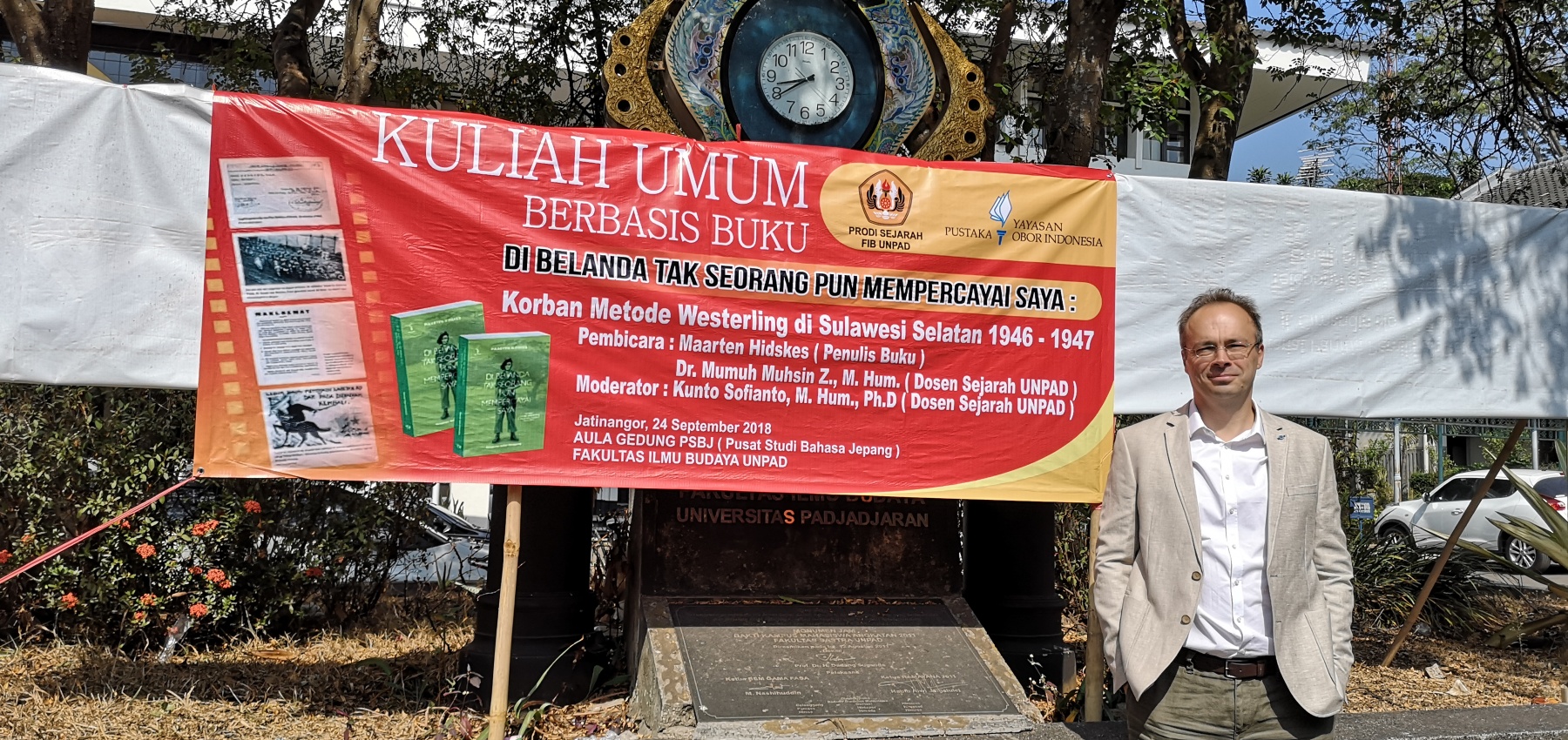Maarten Hidskes travelled some 10,000 kilometres across Indonesia to talk about the theme of his book entitled Thuis gelooft niemand mij (Nobody At Home Would Believe Me), which has now also been translated into Bahasa Indonesia. He visited 11 universities, had conversations with eye witnesses and veterans, and spoke with 1200 history and political science students and dozens of lecturers. While right in the middle of his travels, he heard an Indonesian lecturer expressing what his journey was about: “Your project is about sharing and caring.”
Surabaya, 10 October 2018. It is 11.30 in the morning, and more than 200 students have already been listening to me, to each other and to a couple of lecturers for an hour and a half now. There seems to be no end to the questions from the floor. When did the Dutch government make the information about Captain Westerling public? Are you prepared to enter into discussions with the victims? Why did Westerling never admit that he had committed genocide? All the questions are asked in an open and respectful way but answering them requires some skill. I don’t want my reply to be based on apparent truths. And that was why, 90 minutes earlier, I had started off with a disclaimer: take the information I give on board, but don’t trust in it blindly. My truths will only become meaningful when juxtaposed with your history. The meaning of history is to be found in exchanges.
My thoughts stray back to where it all started. My book and project have their origins in the positive desire I had to tell an eye witness’s story, but also in the irritation I felt about the way in which the country’s colonial past was being discussed in the Netherlands around the turn of the millennium. The media and the legal profession, getting on their own biased hobby horses, dominated these discussions. Any nuanced historiography came later and elsewhere, in articles published on the internet that you really had to know how to find.
I wanted to write the little history of just one contemporary of the time and an eye witness: my father. He was part of a small group of enthusiasts who would go on to open up a wound in South Sulawesi that now, 73 years later, still hasn’t healed. When my father left the island 12 weeks after first landing there, he knew all about the bloody flip side to the good intentions there had been. He knew about his own flip side, that of his army leadership and of his country. For many years, the working title for my research was: ‘With the best of intentions, up to the ankles in blood’. I wanted to get as close as possible to his inner world. I had no interest in providing a broad outline or describing the general political-military situation on the eve of the Linggadjati Agreement. These things are, of course, necessary and worth looking at, essential even. But I wanted to be able to see him, a man made of flesh and blood. On squeezing the trigger, I wanted to see his good intentions evaporate.
But my father was already dead. And so I spoke to ex-commandos who were still alive, pretending that I just wanted to talk about my father. The answers they gave very clearly conveyed the images imprinted on their minds. I was provided with their little stories, their thoughts and considerations. Stories about what Westerling was really like on a day-to-day basis. They imitated him. They quoted him. They demythologized him. The commandos freed themselves from the magic, dark gloss the press and society had painted them with. I was sitting and talking with ordinary men who had been at the forefront of things.
Back in the auditorium, Dhani Saputra stands up. He tells a long and emotional story about his grandfather, who moved over from the KNIL (the Royal Dutch East Indies Army) to the Siliwangi division of the TNI (the Indonesian National Armed Forces). Saputra had tried to find out how this had come about. When had his grandfather transferred? Why? And how difficult or easy was it to do so? And how did his family react? Saputra then addresses the senior lecturer and myself: Inspired by your book, we should now go away and write our own history. So, thank you for sharing your open-minded history!” He is given a standing ovation.
Cold shivers go down my spine. This is, of course, fantastic. Later, the lecturers say that this was not something they had expected. They had been trying for some time to activate a different type of historiography, one that focuses more on oral history, more on a clear distinction between facts and opinions, more on having the courage to form one’s own opinion. Such micro-histories make it much more difficult for people to duck difficult questions, such as ones about the intra-Indonesian conflict. We are able to recognize ourselves in such histories. They are then no longer about heroes. Heroes, we hear some people in the auditorium say – there are enough heroes. It is also almost impossible to turn a hero into a normal person. If we want to understand war, we need normal people. Eye-witness statements provide us with greater insights into history.
- Maarten Hidskes
To read the blogs about the journey to Sulawesi, visit www.thuisgelooftniemandmij.nl
Currently under development: www.dibelanda.id
